Vortex Generators
Flying in and out of a 750' strip, sometimes at
or near gross weight is my MKIII's most valuable ability, so having
the ability to land slower, take off quicker, and enhance the
already good STOL abilities of the MKIII appealed to me, vortex
generators sounded like a good deal, so I gave them a try. Results?
Stall speed dropped from 26 indicated to 20-21 indicated, actual
speed was from roughly 33 mph to somewhere around 27 or 28 mph,
a very nice improvement. But what I hadn't counted on is now it's
most appreciated asset: how it handles in slow flight.
Here's how it works:
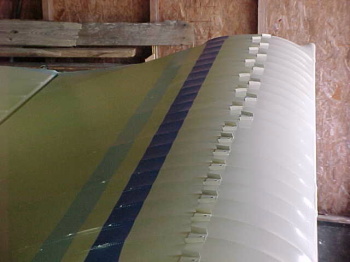 I started out with ten vg's on each side, one on
every other rib near the tip, and then on every fourth rib closer
in. Helped some, but not as much as I wanted. Researching turned
up some data indicating that I needed a lot more of them, and
I also found a web page for VG's on Super Cubs indicating that
it could be helpful to put the ones in front of the aileron further
forward to improve roll control in the stall. Here is the final
product: Most of the vg's are 10" back from the front of
the leading edge to the rear edge of the vg, the ones in front
of the aileron are staggered forward by the width of a vg. There
is a vg on every rib and false rib.
There are 7 alternate vg's per side staggered forward,
starting at the outermost tip rib, their rear edge is even with
the front edge of the adjacent ones , which put their rear edge
8.5" back. Why did I do them that way? I just had a hunch
it might work, and apparently it does. I suspect that the vortexes
interact and enhance each other, but that's just a guess. On the
other hand, it might have done just as good if they were all back
10." For more details on how and why I chose this configuration,
check the addendum at the bottom of this page.
I started out with ten vg's on each side, one on
every other rib near the tip, and then on every fourth rib closer
in. Helped some, but not as much as I wanted. Researching turned
up some data indicating that I needed a lot more of them, and
I also found a web page for VG's on Super Cubs indicating that
it could be helpful to put the ones in front of the aileron further
forward to improve roll control in the stall. Here is the final
product: Most of the vg's are 10" back from the front of
the leading edge to the rear edge of the vg, the ones in front
of the aileron are staggered forward by the width of a vg. There
is a vg on every rib and false rib.
There are 7 alternate vg's per side staggered forward,
starting at the outermost tip rib, their rear edge is even with
the front edge of the adjacent ones , which put their rear edge
8.5" back. Why did I do them that way? I just had a hunch
it might work, and apparently it does. I suspect that the vortexes
interact and enhance each other, but that's just a guess. On the
other hand, it might have done just as good if they were all back
10." For more details on how and why I chose this configuration,
check the addendum at the bottom of this page.
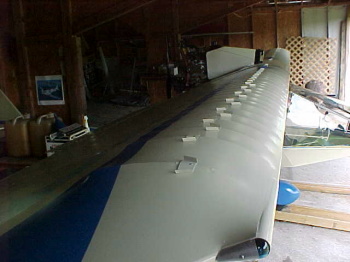 Solo Flight Test Results
Takeoff with slight back stick, seeking to find
minimum controllable liftoff speed shows 30 mph indicated.
Control at the stall break seems good, both straight
ahead and in turns, accelerated stalls at cruise power seem normal.
The pre-stall deck angle is much steeper, and the airframe has
a little more noticeable buffet just before the stall. Best of
all, the airplane no longer wants to mush out of the flare at
slow landing speeds like it used to, I can now shoot approaches
slower than previously. How much slower? From 55 indicated I am
down to 45 indicated solo, and that seems about right for a minimum
approach speed.
Stall with flaps is notably different than pre-vg's.
I have my flap mechanism such that I can have 10 degrees, 20 degrees,
30 degrees and 35 degrees. At ten and 20 degrees, the only difference
you notice is that the airplane stalls more nose up in the power
off attitude, it seems that the angle relative to the horizon
is about a level deck angle at stall. Stall is consistently at
20-21 mph indicated, and as near as I can figure, that is somewhere
around 27-28 actual.
With 30 and 35 degrees of flaps, the airspeed indicator
reveals it's shortcomings, it will not read low enough to tell
me what is really happening at the stall, and things happen a
bit different than before. Up at altitude simulating minimum speed
landings, power off descents at 45 indicated with full flaps,
then an application of aft stick to arrest the descent and maintain
level flight (simulating flare to touchdown) results in the airspeed
indicator steadily falling to 20 indicated and then stopping at
20, but it feels subjectively as if the airplane is still slowing
down, things just sound and feel like it is. At the same time,
the pressure required to hold aft stick diminishes notably. I
suspect that the airplane has gone into "parachute mode,"
sinking rapidly in a level flight attitude. Also, the airplane
starts to want to nose up just a bit.
After about 1-2 seconds of this perceived slowing,
there is a clean sharp break and the nose will pitch down about
15-25 degrees, it is obvious the wing has quit flying. No tendency
to fall off on a wing. Releasing the aft stick pressure gives
an immediate recovery. The stall break and pitch down is notably
sharper than with no flaps, or with ten or 20 degrees of flaps,
but not alarming, it was just obvious that when it quits, it quits,
period. If at any time you release aft stick or add power, it
resumes normal flight.
Since I have no aerobatic training, I have not stalled
it with full power, either with or without flaps. I suspect it
would be pretty exciting, possibly more adrenaline than I really
want to deal with...
I was able to slow flight at 30 indicated, maintaining
level flight at 4700 rpm, doing brisk aileron turns, using healthy
applications of aileron to roll 45 degrees either way, just enough
rudder to keep the ball centered, and the airplane felt fairly
solid and comfortable.
Climb at full power timed for one minute is at least
900 feet/min, even more on cold days. Maximum speed seems to be
unchanged, but cruise may be better than before. The angle of
attack of the wing at cruise speed is lower than before, the wing
now flies flatter relative to the horizon/relative wind in level
flight. Power off landings solo at minimum approach speed, maintaining
45 down final, full flaps, power off all the way to touchdown
is tricky, the airspeed plays out quickly in the flare. Maintaining
about 3500 rpm on final until just before the flare makes it very
easy to hold 45 mph.
Wheel landings work best with vg's, because full
stall landings tend to get the tailwheel touching down first,
which then plops the airplane down on the mains.
Solo Flight Test Results
Takeoff with slight back stick, seeking to find
minimum controllable liftoff speed shows 30 mph indicated.
Control at the stall break seems good, both straight
ahead and in turns, accelerated stalls at cruise power seem normal.
The pre-stall deck angle is much steeper, and the airframe has
a little more noticeable buffet just before the stall. Best of
all, the airplane no longer wants to mush out of the flare at
slow landing speeds like it used to, I can now shoot approaches
slower than previously. How much slower? From 55 indicated I am
down to 45 indicated solo, and that seems about right for a minimum
approach speed.
Stall with flaps is notably different than pre-vg's.
I have my flap mechanism such that I can have 10 degrees, 20 degrees,
30 degrees and 35 degrees. At ten and 20 degrees, the only difference
you notice is that the airplane stalls more nose up in the power
off attitude, it seems that the angle relative to the horizon
is about a level deck angle at stall. Stall is consistently at
20-21 mph indicated, and as near as I can figure, that is somewhere
around 27-28 actual.
With 30 and 35 degrees of flaps, the airspeed indicator
reveals it's shortcomings, it will not read low enough to tell
me what is really happening at the stall, and things happen a
bit different than before. Up at altitude simulating minimum speed
landings, power off descents at 45 indicated with full flaps,
then an application of aft stick to arrest the descent and maintain
level flight (simulating flare to touchdown) results in the airspeed
indicator steadily falling to 20 indicated and then stopping at
20, but it feels subjectively as if the airplane is still slowing
down, things just sound and feel like it is. At the same time,
the pressure required to hold aft stick diminishes notably. I
suspect that the airplane has gone into "parachute mode,"
sinking rapidly in a level flight attitude. Also, the airplane
starts to want to nose up just a bit.
After about 1-2 seconds of this perceived slowing,
there is a clean sharp break and the nose will pitch down about
15-25 degrees, it is obvious the wing has quit flying. No tendency
to fall off on a wing. Releasing the aft stick pressure gives
an immediate recovery. The stall break and pitch down is notably
sharper than with no flaps, or with ten or 20 degrees of flaps,
but not alarming, it was just obvious that when it quits, it quits,
period. If at any time you release aft stick or add power, it
resumes normal flight.
Since I have no aerobatic training, I have not stalled
it with full power, either with or without flaps. I suspect it
would be pretty exciting, possibly more adrenaline than I really
want to deal with...
I was able to slow flight at 30 indicated, maintaining
level flight at 4700 rpm, doing brisk aileron turns, using healthy
applications of aileron to roll 45 degrees either way, just enough
rudder to keep the ball centered, and the airplane felt fairly
solid and comfortable.
Climb at full power timed for one minute is at least
900 feet/min, even more on cold days. Maximum speed seems to be
unchanged, but cruise may be better than before. The angle of
attack of the wing at cruise speed is lower than before, the wing
now flies flatter relative to the horizon/relative wind in level
flight. Power off landings solo at minimum approach speed, maintaining
45 down final, full flaps, power off all the way to touchdown
is tricky, the airspeed plays out quickly in the flare. Maintaining
about 3500 rpm on final until just before the flare makes it very
easy to hold 45 mph.
Wheel landings work best with vg's, because full
stall landings tend to get the tailwheel touching down first,
which then plops the airplane down on the mains.
Dual
Flight Test Results
With two full size people in it, throttle at idle,
45 mph on final, you can get yourself in trouble in the flare.
Especially with full flaps. The airplane will now fly so slow
that the elevator starts to lose control authority at that speed
when you pull back on the stick to flare, and the nose will not
raise normally. Consequently, I also added VG's to the underside
of the horizontal stab and gap sealed the stab to the elevator.
Results were outstanding, with a heavy passenger, both with and
without flaps, control authority at slow speeds is substantially
improved. Here is what it looks like:
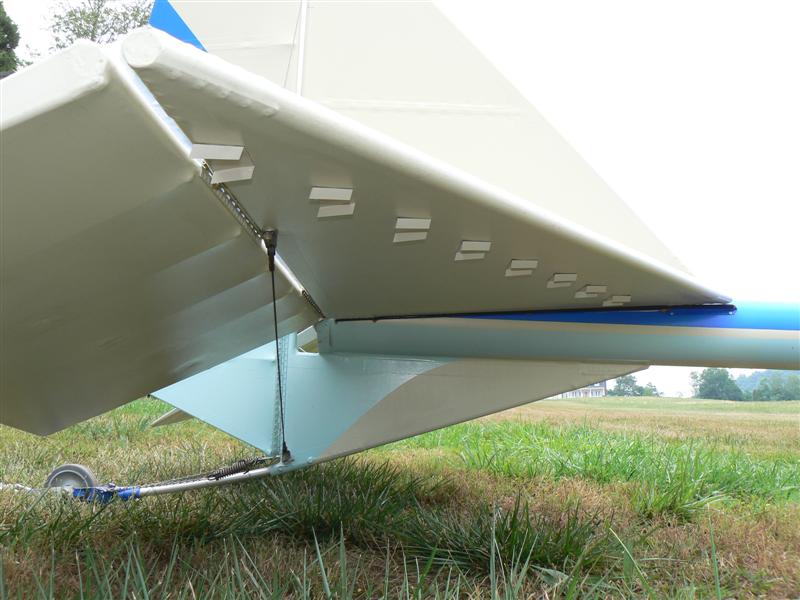 In any event, you want to keep at least 50 on final
when you have a passenger.
In any event, you want to keep at least 50 on final
when you have a passenger.
If I had it to do over, I would
just buy vg's from STOLSPEED - great for the price
But - for the frugal - here is how
to do it cheap
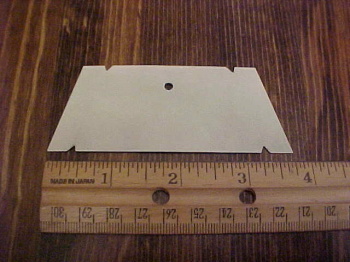 Made the vg's from soft aluminum strips, cut out
of some surplus aluminum guttering, which is sturdy enough for
the purpose, light, and easy to paint. Above is the pattern I
used to draw the vg's on the aluminum strips with, 3.75 inches
on the back side, 2.75 inches on the front side, 1.5 inches front
to back, and bent to 3/8" high at the vane. (That's what
the notches in the pattern are for, just to indicate the 3/8"
bend line, don't cut any notches into your vg's!) I riveted them
to the ribs with one rivet and also glued them down with Goop,
(WalMart, sporting goods section) which adheres to Stits like
crazy. They didn't really need the rivet. Don't use rivets on
yours. You can easily bend them to conform to the shape of the
wing and rib. Be sure and smooth off the edges of the vanes, and
round off the sharp corners, or the next time you wash the wing,
you will cut the fool out of yourself and bleed on your airplane.
(Guess how I know this?)
Made the vg's from soft aluminum strips, cut out
of some surplus aluminum guttering, which is sturdy enough for
the purpose, light, and easy to paint. Above is the pattern I
used to draw the vg's on the aluminum strips with, 3.75 inches
on the back side, 2.75 inches on the front side, 1.5 inches front
to back, and bent to 3/8" high at the vane. (That's what
the notches in the pattern are for, just to indicate the 3/8"
bend line, don't cut any notches into your vg's!) I riveted them
to the ribs with one rivet and also glued them down with Goop,
(WalMart, sporting goods section) which adheres to Stits like
crazy. They didn't really need the rivet. Don't use rivets on
yours. You can easily bend them to conform to the shape of the
wing and rib. Be sure and smooth off the edges of the vanes, and
round off the sharp corners, or the next time you wash the wing,
you will cut the fool out of yourself and bleed on your airplane.
(Guess how I know this?)
How do you measure back from the leading edge to get the
10" and 8.5" figures? You make a measuring tool. 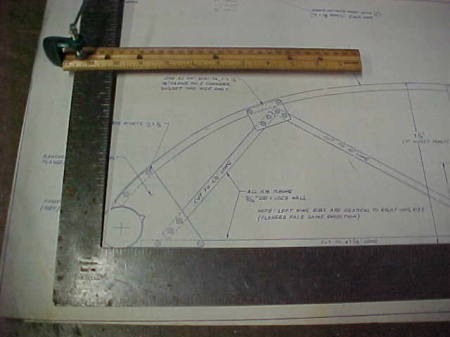
Here is the concept. A square, a clamp and a ruler.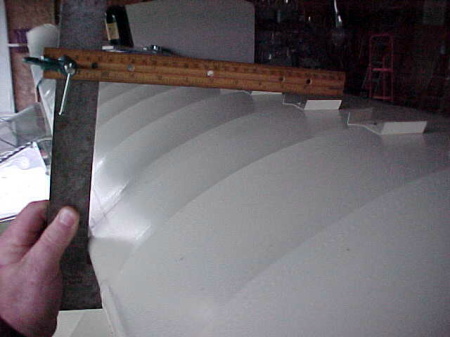 Here is the application. Make
a mark, stretch a string.
Here is the application. Make
a mark, stretch a string.
Others on the Kolb list have tried variations on
the number and placement of the vg's. Vince Nicely, who lives
nearby and provided much of my guidance in this direction has
the vg's on his FSII at 11 inches back, and has obtained similar
results. IMHO, this is one of those areas where there is probably
an ideal position and number of vg's used, but apparently a sufficient
number of vg's anywhere between 10" and 11" inches back
will work pretty well.
Conclusions? I think the MKIII gets off the ground
quicker, it certainly climbs out much better, lands slower solo,
and control response in slow flight feels as solid as at cruise
speeds, which is certainly the most important factor of all. Having
the airplane fly rock solid 10 mph above the stall is much more
valuable than merely stalling slower.
Subjectively, the airplane seems "lighter"
and very pleasant, almost as if it weighed much less. I am well
satisfied with vg's on the MKIII. Cost to make and install them?
Under ten dollars and less than eight hours of time including
paint and cosmetics. That much improvement for that little money
is a real bargain.
But once again, if I had it to do over, I would
just send STOLSPEED some money and use theirs.
Addendum - February 25, 2007
It has recently been brought to my attention that
a certain individual who represents himself as a guru on another
homebuilders web page has seen fit to describe my process of choosing
the number and placement of vg's on my MKIII as being nothing
more than "placing a haphazard amount of eyeballed VG strips
on the wing." I assume that this is because I had not thought
it fitting or necessary to go into all that was involved in my
process of choosing the number and placement of vg's. The purpose
of this page is not to impress anybody with what a great meticulous
experimenter I am, but to save other Kolbers from reinventing
the wheel.
However, since the usefulness of this modification
has been brought into question, here is how I chose the number,
size and position of the vortex generators on my Kolb.
I am not the first experimenter to try vortex generators
on a Kolb. Jack Hart's use of vg's on his Kolb (all current high-wing
pusher Kolb's use the same airfoil and wing planform) covers many
years of experience and were an invaluable help. You can find
his excellent website here
and several pages on vg's beginning here.
A respected friend, Vince Nicely, has flown a Kolb
Firestar II for a number of years, he is a true scientist in the
most literal way, and had made a huge number of carefully documented
notes on his experiments with vortex generators. Since the Kolb
MKIII and the Firestar II have an identical airfoil, and a similar
wing, it was not too much of a stretch to work confidently from
the premise that what worked on his airplane would apply in at
least some fashion to mine. So I used his notes as my baseline.
I spent several months reading everything I could
find on the topic. I began my efforts by duplicating Vince's efforts
exactly. Several hours of testing followed. Then came modifications,
increasing the number of vg's and also moving them slightly fore
and aft, looking for the optimum placement. The placement of vg's
on Cubcrafter's Super Cub wing impressed me greatly, using a staggered
location ahead of the ailerons, and in the process discovered
that a mixed stagger seemed to work very well on my wing. (That
web page is gone now but it was like this)
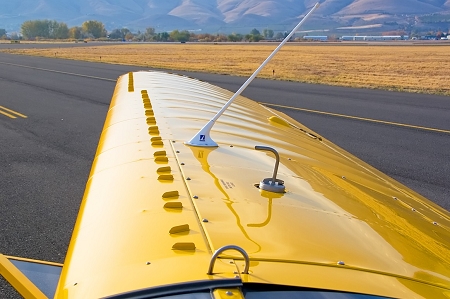 Then came more flight testing, in both calm and
active air. All tests were done using a mini voice recorder so
that I could record slow flight and stall speeds, objective and
subjective changes and differences in aircraft behavior as promptly
as I noticed them, without having to write anything down. Flight
testing included unusual attitudes, but no aerobatic maneuvers
or spins. Deep stalls were a concern and were extensively explored.
By the time I had finished, I was satisfied that my results were
an improvement and enhanced the safety and pleasure of flight
of what was already a good flying airplane. At that point I put
up this web page to share what I had learned.
Subsequently I was involved in the building and
the initial 40 hours of flight testing of a Kolb FirestarII during
which time vg's were added to it. Flight testing and vg modifications
on that aircraft took over a month of flying several times a week
before satisfactory results were obtained. Several different configurations
were tried, based once again on previous known good configurations.
The final results were different from my experience with the MKIII,
and the configuration of Vince's FSII. Notably, all configurations
were an improvement over the bare wing, but some configurations
were better than others, and the final configuration chosen was
selected for it's consistent and benign handling qualities. Since
I am not a professional aerodynamicist, I cannot tell you why
something works best a particular way, simply that it does. If
that makes me cannon fodder for someone who knows nothing about
the specifics of what I did or how I did it, so be it.
Bottom line - this vg placement and configuration
works on my MKIII, you might prefer something differnt on yours.
If you decide to add vg's to your Kolb, (and this is a Kolb page,
what is on this page may not pertain to non-Kolbs) what you find
here might be a good starting point, as would Jack Hart's page.
My advice is to consult with those who have actual experience
with your type of aircraft or very similar, (whom you trust and
whose judgement you respect) think, study, learn, start cautiously,
explore gradually, take notes, and enjoy how much nicer your airplane
will fly when you get done.
PS: Vince also tried vg's on his Sonerai. Exhaustively.
They did nothing useful. Depending on your non-Kolb airfoil, vg's
may be an exercise in futility. Be advised...
Then came more flight testing, in both calm and
active air. All tests were done using a mini voice recorder so
that I could record slow flight and stall speeds, objective and
subjective changes and differences in aircraft behavior as promptly
as I noticed them, without having to write anything down. Flight
testing included unusual attitudes, but no aerobatic maneuvers
or spins. Deep stalls were a concern and were extensively explored.
By the time I had finished, I was satisfied that my results were
an improvement and enhanced the safety and pleasure of flight
of what was already a good flying airplane. At that point I put
up this web page to share what I had learned.
Subsequently I was involved in the building and
the initial 40 hours of flight testing of a Kolb FirestarII during
which time vg's were added to it. Flight testing and vg modifications
on that aircraft took over a month of flying several times a week
before satisfactory results were obtained. Several different configurations
were tried, based once again on previous known good configurations.
The final results were different from my experience with the MKIII,
and the configuration of Vince's FSII. Notably, all configurations
were an improvement over the bare wing, but some configurations
were better than others, and the final configuration chosen was
selected for it's consistent and benign handling qualities. Since
I am not a professional aerodynamicist, I cannot tell you why
something works best a particular way, simply that it does. If
that makes me cannon fodder for someone who knows nothing about
the specifics of what I did or how I did it, so be it.
Bottom line - this vg placement and configuration
works on my MKIII, you might prefer something differnt on yours.
If you decide to add vg's to your Kolb, (and this is a Kolb page,
what is on this page may not pertain to non-Kolbs) what you find
here might be a good starting point, as would Jack Hart's page.
My advice is to consult with those who have actual experience
with your type of aircraft or very similar, (whom you trust and
whose judgement you respect) think, study, learn, start cautiously,
explore gradually, take notes, and enjoy how much nicer your airplane
will fly when you get done.
PS: Vince also tried vg's on his Sonerai. Exhaustively.
They did nothing useful. Depending on your non-Kolb airfoil, vg's
may be an exercise in futility. Be advised...



 Here is the application. Make
a mark, stretch a string.
Here is the application. Make
a mark, stretch a string.